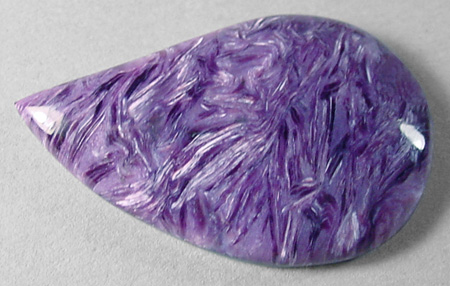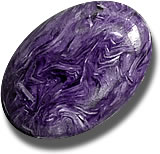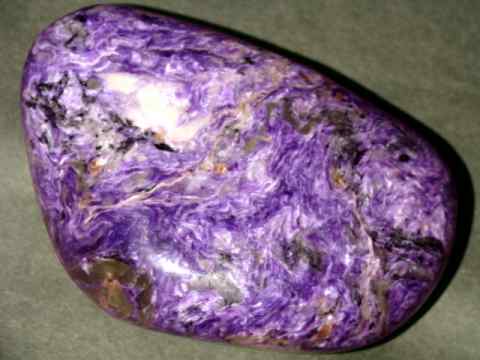Charoite
- IMA 1977-019
The mineral Charoite ( German correct charoite ) is a rarely occurring chain silicate from the mineral class of silicates. It crystallizes in the monoclinic crystal system with the general chemical composition ( K, Na ) 5 ( Ca, Ba, Sr) 8 [( OH, F ) | Si6O16 | ( Si6O15 ) 2] n · H2O. The values given in the parentheses elements potassium, sodium, calcium, barium and strontium as well as within the square brackets is the hydroxide and fluoride can in the formula each represent each other (substitution, Diadochie ), but are always in the same proportions to the other components of the Minerals.
Charoite developed translucent to opaque, massive or fibrous aggregates in violet and white stripes, where the stripes are swirled into each other and can sometimes contain dark inclusions. Charoite is sought after as a gemstone high.
Etymology and history
Violet rocks in the form of blocks Tschara were in the area of the river first discovered in 1948 and erroneously described as cummingtonite schist ( cummingtonite is a magnesium iron silicate; Charoite and however the accompanying minerals contain no magnesium ). In the 1960s, the Irkutsk geologists couple Rogow discovered the actual reservoir in the water -shed between the Chara and its tributary Tokko. In the 1970s, the deposit was investigated in detail, and in 1976 the mineral described. Since 1978 it is recorded as a recognized mineral in the list of IMA. According to Russian sources, the mineral unanimously by the occurrence in the catchment area of the river Chara (Russian Чара, English transcription Chara ) was named. According to other sources, the term refers to the equally appropriate Russian word tschary ( чары ), what kind of magic in the sense of charming, enchanting is pathetic.
Classification
Already in the now outdated but still in use 8th edition of the mineral classification by Strunz was one of Charoit for mineral class of " silicates and Germanates " and then to the Department of " chain silicates and phyllosilicates ( inosilicates ) " where he along with canasite, Eveslogit, Frankamenit, Miserit and Yuksporit the unnamed group VIII/F.35 formed.
The 9th edition valid since 2001 and of the International Mineralogical Association (IMA ) used the Strunz'schen Mineral classification assigns the Charoit also in the class of " silicates and Germanates " and there in the department of " chains and chain silicates " one. This division, however, is further subdivided according to the type of chain formation, so that the mineral is " with 3- periodic single and multiple chains chains and chain silicates " to find according to its composition in the subdivision where it only as a single member, the unnamed group 9 forms. DG.32.
The mainly common in English-speaking classification of minerals according to Dana assigns the Charoit in the class of " silicates and Germanates " there, however, in the department of " chain silicates: Column or Tube Structures" one. Here he is with Narsarsukit and Caysichit - (Y) in the group of " double cranked chains " with the system no. 70.01.02 within the subdivision: to find " chain silicates columns or tubular structures with columnar silicate units."
Education and Locations
Charoite is formed hydrothermally in volcanic rocks. It is accompanied by a wide variety of minerals such as aegirine, feldspar, nepheline, quartz and others.
Type locality is the area of up to 1452 meters high Murunmassivs ( Lage58.373055555556118.92361111111 ) on the border between the Russian administrative units Irkutsk Oblast, Republic of Sakha (Yakutia ) and the Trans-Baikal region. It extends about 70 kilometers south-east of the situated at the mouth of Shuya in the Chara Chara village (also Ust- Shuya ) and 40 kilometers west of the urban-type settlement Torgo, located on the same tributary of the Tokko in Rajon Oljokminsk.
This is practically the only place to find, especially in the eastern part of the massif. On the Sirenewy Kamen (lilac -colored rock ) shall deposit the annual funding is approved by 100 tons. The export from Russia is theoretically permitted only in edited form.
Crystal structure
Charoite crystallizes in the monoclinic space group P21 / m ( Raumgruppen-Nr. 11) with the lattice parameters a = 32.11 Å; b = 19.77 Å; c = 7.23 Å and β = 95.85 ° and two formula units per unit cell.
Use
Charoite is used exclusively as a gemstone, either for jewelry or sculptures. There is a possibility of confusion with amethyst.










